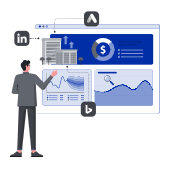Discover B2B SEM tips for small businesses in the USA and China. This guide covers keyword research, platform preferences, and optimization strategies to help you succeed.
For small businesses, B2B Search Engine Marketing (SEM) can be a game-changer. It allows you to reach decision-makers, generate high-quality leads, and compete with larger players. However, the strategies that work in one market may not be effective in another. This is especially true for the USA and China, two of the largest and most diverse B2B markets in the world.
In this blog, we’ll explore B2B SEM tips for small businesses in the USA and China. From keyword research to platform preferences, we’ll cover everything you need to succeed in these competitive markets. Let’s dive in!
Why B2B SEM Matters for Small Businesses
B2B SEM offers small businesses a cost-effective way to reach their target audience. Here’s why it’s crucial:
- Targeted Reach: Reach decision-makers actively searching for your solutions.
- Measurable Results: Track clicks, conversions, and ROI in real-time.
- Scalability: Start small and scale your efforts as your business grows.
- Competitive Edge: Compete with larger businesses by targeting niche markets.
In short, B2B SEM levels the playing field for small businesses.
B2B SEM Tips for the USA
The USA is a mature market with high competition. Here’s how small businesses can succeed:
1. Focus on Long-Tail Keywords
- Long-tail keywords are less competitive and more specific.
- Example: Instead of “CRM software,” target “best CRM software for small businesses.”
- Use tools like Google Keyword Planner or SEMrush to find relevant keywords.
2. Leverage Google Ads
- Google Ads is the most popular SEM platform in the USA.
- Use Target CPA or Target ROAS bidding strategies to maximize ROI.
- Optimize for mobile, as over 60% of searches come from mobile devices.
3. Use LinkedIn Ads
- LinkedIn is ideal for reaching decision-makers like CEOs and IT managers.
- Target by job title, industry, and company size.
- Promote whitepapers, case studies, or webinars to build credibility.
4. Optimize Landing Pages
- Ensure your landing pages align with your ad messaging.
- Use clear CTAs like “Request a Demo” or “Download Now.”
- Test different designs and copy to improve conversions.
Pro Tip: Use Google Analytics to track performance and identify areas for improvement.
B2B SEM Tips for China
China is a unique market with its own set of challenges and opportunities. Here’s how small businesses can succeed:
1. Focus on Baidu Ads
- Baidu is China’s leading search engine, with over 70% market share.
- Use Baidu Keyword Tool to find relevant keywords in Mandarin.
- Optimize for mobile, as most Chinese users browse on smartphones.
2. Leverage WeChat Ads
- WeChat is China’s most popular social media platform, with over 1.2 billion users.
- Use WeChat Ads to reach decision-makers and promote your products or services.
- Combine ads with WeChat Official Accounts for a comprehensive marketing strategy.
3. Localize Your Content
- Translate your content into Mandarin and adapt it to Chinese culture.
- Use culturally relevant examples and avoid direct translations.
- Example: Highlight how your product supports China’s “Double 11” shopping festival.
4. Partner with Local Influencers
- Collaborate with Key Opinion Leaders (KOLs) to promote your brand.
- Use platforms like Weibo or Douyin (TikTok) to reach a broader audience.
- Example: Partner with a tech KOL to review your software solution.
Pro Tip: Use Baidu Webmaster Tools to monitor your website’s performance in China.
Common B2B SEM Challenges for Small Businesses
Small businesses face unique challenges in B2B SEM. Here’s how to overcome them:
1. Limited Budget
- Start with a small budget and focus on high-impact campaigns.
- Use cost-effective platforms like Google Ads or Baidu Ads.
2. Lack of Expertise
- Invest in training or hire a freelance SEM specialist.
- Use tools like SEMrush or HubSpot to simplify campaign management.
3. Competition from Larger Businesses
- Focus on niche markets and long-tail keywords.
- Highlight your unique selling points (USPs) to stand out.
4. Measuring ROI
- Use analytics tools to track performance and adjust your strategy.
- Focus on metrics like CPC, conversion rate, and ROAS.
Pro Tip: Use Google’s Performance Planner to forecast campaign performance and optimize your budget.
Tools for B2B SEM Success
Here are some tools to help small businesses succeed in B2B SEM:
1. Google Ads
- For running search and display campaigns in the USA.
2. Baidu Ads
- For running search campaigns in China.
3. LinkedIn Ads
- For reaching decision-makers in the USA and globally.
4. SEMrush
- For keyword research, competitor analysis, and campaign tracking.
5. Unbounce
- For creating high-converting landing pages.
6. Google Analytics
- For tracking website traffic and user behavior.
Pro Tip: Use UTM parameters to track the performance of specific campaigns and ads.
Conclusion
B2B SEM is a powerful tool for small businesses in the USA and China. By focusing on the right platforms, optimizing your campaigns, and leveraging local insights, you can reach decision-makers, generate high-quality leads, and grow your business.
Remember, B2B SEM is an ongoing process. Regularly monitor performance, test new strategies, and refine your approach to stay ahead of the competition. With the right tools and strategies, you can turn your B2B SEM efforts into a significant driver of growth and success. You can contact us for a B2B SEM plan; we will handle everything for you.











